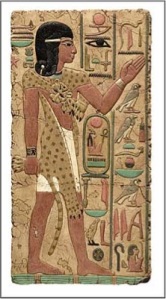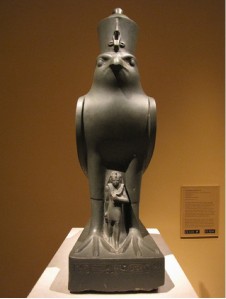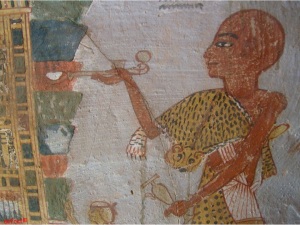Hetepu (Peace) Family.
In the past few days, I have had some people ask me why Kamitic/Kemetic shamanism? Well, before answering that question, it should be noted that…
 Kamitic/Kemetic priest in leopard pelt
Kamitic/Kemetic priest in leopard pelt
…in 1972, a 50, 000 year-old-Neanderthal burial site was unearthed in Southern France by two French archeologists. The burial site, which became known as the Hortus site, contained the remains of a man wearing a leopard skin with claws and tails still intact, but no leopard bones were found in the grave. The only cultural comparisons the archeologists had on record, was that in other culture, tribal shamans were known to wear similar capes made from animal skins and be buried with ritual objects. The archeologists concluded that the man must have been a shaman. My question is how come the same conclusion is not drawn about the Kamitic/Kemetic (ancient Egyptians) priests and priestesses who were known to wear similar garments and be buried with ritual objects as well?
Could it be, that if the Kamitic/Kemetic priesthood were actually shamans, it would mean that Kamitic spirituality is at least 50,000 years-old or older?
Could it be, that by calling the Kamitic/Kemetic priesthood and society itself a shamanic culture, it would cause some to sympathize with traditional African people, the same way people did after it was realized globally what colonizers had done in degrading the culture of the Native Americans and indigenous Australians? Maybe?
Well, I tend to think the conspiracy is a little deeper than the above reasons because shamanism is not a religion. Shamanism is a time-tested, widespread, practical, healing, spiritual system that is not bound by any land, people, culture, language, etc. In other words, it is not bound by doctrine, dogma or a set of holy rules. It is a spiritual tradition that only those who have been called and have acknowledged the call can be shamans, but the tradition itself can be practiced by anyone. This would mean, that the reason the same conclusion was not reached about the Kamitic/Kemetic society being a shamanic culture is because if it were the case. People would realize that if the Kamitic people achieved greatness by tapping into their divinity without any religious order, they could achieve similar results. Therefore, it serves the religious few for people to believe that there is a need for organized religion.
I believe also if it were stated that the Kamitic/Kemetic people were a shamanic culture it would unite them with the rest of traditional Africa, who not only followed but continue to practice the custom of burying their dead with the last objects the individual used, which archeologists referred to as treasures. Here is a listing of the most common items buried with the dead. Many of these items you will find early African Americans of Kongo descent placed on their deceased loved one’s graves. Many of these practices are still practiced in the United States.
• Personal Belongings – It was customary for the most personal belongings of the deceased, such as their eating utensils, walking sticks, blankets, etc., to be buried with them. Favorite pieces of jewelry were bured with the dead, along with decorations from the home.
• Seashells – Seashells (especially white) are associated with the spirit world in many early African religions. They believed the world of the dead was connected to the living by the ocean or water.
• Broken Pottery – Pottery that belonged to the departed is often broken on top of their grave so their spirit would not come looking for them. Incorporate broken bottle pieces into your African funeral tribute. You could use some of your loved one’s items, or terracotta pots.
• Lamps/Fire – Oil lamps or bonfires were used in traditional African funerals because the light pointed the way to glory. Create a tribute around a central flame or flame bowl.
• Mirror Pieces – Mirror pieces and other shiny objects were often used in traditional African funerals. It was thought that their ancestral spirits could be seen in the reflection. Use mirror pieces, gold or other reflective pieces in your African funeral tribute.
So, the question, why Kamitic/Kemetic shamanism?
Well, besides the reasons given above, because shamanism is not a religion. It doesn’t require that you practice it once or twice a week. There is no obligation. It is not based upon theory but upon physical, tangible results. If it works you use it. If it doesn’t you don’t use it. It’s that Simple. There is no one forcing or goading you into doing something that you do not agree, believe or comprehend. You don’t mimic what other cultures have done nor do you have wear elaborate costumes. None of that is necessary because it is not about mimicking forms. At the same time it challenges you to live correctly by rewarding you when you do live according to Maa (balance/truth) because it focuses on spiritual content. When you do not live according to Maa, you don’t advance or achieve your goals. This isn’t a punishment from some Supreme Deity, it is simply the consequences of your actions and behaviors.

The interesting thing about shamanism is that all of the books in the world can help you but none of them will prepare you for this mystical journey. This is the problem with a lot of traditions. They have a set of recipes on how to do something based upon some old records or grimoires but they don’t have the discipline or the wisdom to carry it out. This is not the case in shamanistic practices because it is a spiritual healing practice based mainly upon trial and error. Where you acquire more divine power through your own self-discipline. Some people might not like this approach and prefer to be told the rules and the how-to’s. The advantage of not having any rules or “no regla” as it is called in Spanish, is that you work directly with your Spirits, which is easier in some ways because you are not following exact recipes.
So, this is some of the reasons why I follow the Kamitic/Kemetic shamanic path.
Hope that helps.
Derric “Rau Khu” Moore


Europeans will always try to dehumanize anything that comes out of African mythology, science and medicine. Yet, being non-indigenius, they have no choice but to steal it and claim it as their own.
Good luck on your journey.